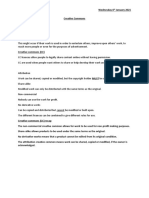100% found this document useful (1 vote)
43 views9 pagesUnderstanding Creative Commons Licenses
Creative Commons (CC) is a licensing system that enables creators to share their work under specific permissions. Users can share and adapt CC content while adhering to obligations such as attribution and restrictions on commercial use. The licenses promote creativity and collaboration by balancing creators' rights with public access.
Uploaded by
focylangdruCopyright
© © All Rights Reserved
We take content rights seriously. If you suspect this is your content, claim it here.
Available Formats
Download as PPTX, PDF, TXT or read online on Scribd
100% found this document useful (1 vote)
43 views9 pagesUnderstanding Creative Commons Licenses
Creative Commons (CC) is a licensing system that enables creators to share their work under specific permissions. Users can share and adapt CC content while adhering to obligations such as attribution and restrictions on commercial use. The licenses promote creativity and collaboration by balancing creators' rights with public access.
Uploaded by
focylangdruCopyright
© © All Rights Reserved
We take content rights seriously. If you suspect this is your content, claim it here.
Available Formats
Download as PPTX, PDF, TXT or read online on Scribd
/ 9


















































